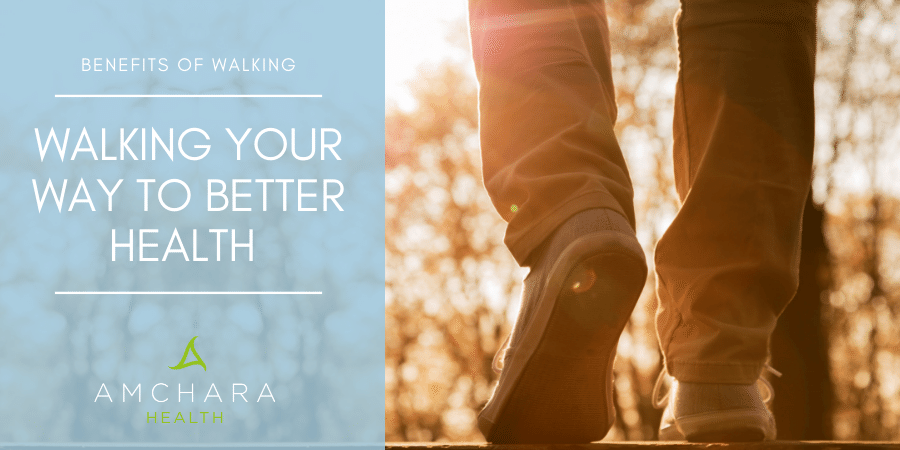Topics Covered in this article:
Walking is something we do every day without thinking, yet it can benefit our health in numerous ways.
In this article we’ll discover the health benefits of walking, and how you can incorporate more steps into your day.
Health benefits of walking
Hippocrates, the father of medicine, is thought to have said, “walking is man’s best medicine”.
Although any exercise will benefit our health, what’s so special about walking?
Studies have found as little as just 30 minutes walking per day can improve cardiovascular health, reduce fat and strengthen muscle, as well as decreasing the risk of Type 2 diabetes, osteoporosis and even certain cancers.
Walking can improve balance and co-ordination and can also boost mood.
In fact, in several long term studies, walking has been found to be associated with longevity.
Walking is free, low impact and doesn’t need any special equipment other than a pair of shoes.
It can be done alone or with others, at your own pace and to fit in with your day.
Walking is a form of weight-bearing exercise. You don’t need to walk around carrying dumbbells or a huge backpack – you are simply carrying your own body weight.
Walking is low intensity, meaning it’s kind to your joints.
It helps to improve blood flow and also relieve stress, because in contrast to more vigorous forms of exercise, less stress hormone is produced when we walk.
Let’s have a look in detail at some of the health benefits of walking.
- Walking aids weight loss
While any exercise can help weight management, walking appears to be able to switch off obesity genes.
In other words, people who are genetically programmed towards obesity can prevent the effects of these genes by regularly walking.
- Walking supports heart health
Walking for a minimum of 30 minutes per day five days per week has been found in research to reduce the risk of heart disease by 19%.
The further the participants walked, the more their risk was reduced (1).
It’s possible walking is so beneficial because it encourages healthy blood flow without putting strain on the heart.
- Walking and blood sugar levels
Walking, particularly after meals, may help balance blood sugar levels.
In one study, older adults at risk of prediabetes walked for either 15 minutes after meals three times daily, or 45 minutes in one session at any time of the day.
Splitting the walking into three sections significantly improved blood glucose levels compared to exercising all at one time (2).
It follows walking may help curb sugar cravings.
One study which replicated a workplace situation found a 15 minute walk reduced chocolate cravings among regular chocolate eaters (3).
- Walking boosts your energy
In another study involving sleep-deprived volunteers, ten minutes of walking up a flight of stairs boosted energy more than an espresso coffee (4).
So, next time you feel your energy flagging, go for a walk instead of reaching for caffeine!
- Walking and immunity
Going for a walk may even boost your immune system.
Walking at a moderate pace for between 30-45 minutes daily, five days per week during the winter was found in one study to be correlated with 43% less sick days and fewer respiratory tract infections when compared to walking only once per week.
If the walkers did become sick, they were ill for a shorter duration and their symptoms weren’t as severe (5).
- Joint health and walking
Walking can reduce joint stiffness and strengthen the muscles which support the joints.
Research has found walking can decrease the pain of arthritis.
- Walking for mental health
Walking can naturally decrease anxiety and boost mood, as well as improving self-esteem.
In one study, a walk around a university campus as opposed to a video tour of the area improved the happiness of students, even when they were expecting an adverse experience at the end of the walk – in this case, the task of writing an essay (6).
- Walking and brain function
Over eight years, researchers followed a number of older people and found walking an average of 8,900 steps per day was correlated with a reduced risk of cognitive decline, a factor in dementia and Alzheimer’s disease.
The benefit was even seen in those who had already started to show brain changes related to dementia (7).
- Walking can help creative thinking
Participants in one study were able to come up with new ideas more easily when they were walking, especially when they walked outdoors, as opposed to when they were sitting in an office environment.
So if you want to get creative, get outside and walk.
Why ten thousand steps?
Many people find it useful to wear a pedometer or fitness tracker to count the number of steps taken each day, which encourages them to walk more.
Apps are also available to do this on your phone.
You’ll see the golden goal of ten thousand steps per day frequently recommended.
It might surprise you to learn the magical ten thousand step count is a completely arbitrary figure.
It arose from a Japanese marketing campaign for a pedometer in the lead up to the 1964 Olympic Games, rather than from scientific studies to determine how many steps per day are needed to deliver optimal health benefits.
One recent study found the more steps taken per day, the lower the mortality rates – up to a plateauing of the effect at around 7500 steps per day (8), although in the study mentioned earlier on dementia, almost 9,000 seemed to be the most beneficial.
Although it’s difficult to separate cause and effect – people could take fewer steps because they are unwell, or they could take more steps because they are generally more active or have a different mental attitude – there is clearly an incremental link between the amount of walking and good health.
For most people, taking 10,000 steps per day equates to around an hour and a half of walking.
It can be inspiring to reach your daily goal but on the other hand it may be demoralising if you don’t.
If people consistently fail to achieve their target, they could simply give up trying.
One study found people who tracked their daily step count did tend to walk further, but they did not enjoyed walking as much, as it became a chore.
As a consequence they were less happy (9).
Even people who find it easy to meet their target may subconsciously stop when they reach ten thousand steps, rather than carrying on walking.
The moral of all this is to try and walk as much as possible, but do it with a positive mindset and don’t beat yourself up if you miss your daily target.
How to walk
It may seem obvious, but have you ever considered how you walk?
Most of us walk without consciously thinking about it, but proper posture is important.
Good posture encourages deeper breathing, the involvement of core muscles, and the use of leg and buttock muscles to launch into your stride.
Ideally, walk with your head up, your back straight and neck and back relaxed, with your gaze facing forward rather than at the ground.
While walking, swing your arms with a 90 degree bend at the elbow.
Moving your arms can burn more calories and help you walk faster.
Roll your feet smoothly, touching down from heel to toe with a rolling motion, and pushing off with your toe.
Make sure your shoes are comfortable, ideally with good arch support and cushioning of the sole.
Drink plenty of fluids before and after your walk and take water with you if you’re going for a long walk.
Warm up as you set off by walking slowly at first.
After your walk, stretch your leg muscles, holding each stretch for around 20 seconds.
Cooling down and stretching will prevent stiffness and injury.
Strategies to increase walking
Walking is associated with longevity, with one study finding brisk walking is associated with a 20% risk of mortality from any causes (10), whilst other studies suggest walking can even reduce the risk of developing various cancers.
Despite this clear association between walking and health, just over 40% of ten middle-aged adults in the UK only manage one brisk ten minute walk per month.
Ideally, initially aim for at least 30 minutes per day, walking as briskly as you can manage.
The definition of a brisk walk is one during which you can still carry on a conversation, but you are slightly out of breath and wouldn’t be able to sing.
As your fitness improves, you’ll be able to increase the intensity of your walking by increasing to a faster pace or including hills in your route.
If you can’t fit 30 minutes walking into your day in one stretch, try regular small bouts of walking of ten minutes or so at least three times daily.
You may find easier to stick to your walking plan if you make it part of your daily routine or buddy up with a friend and commit to a regular walking schedule together.
With a little planning it’s easy to fit more walking into even a busy day.
Try these simple strategies to increase your daily step count:
- Get off the bus or train one stop before your destination and walk the rest of the way.
- Take the stairs instead of the lift, if only for the last floor or couple of floors.
- Park further away from the office than usual, even if it simply means parking in the far corner of the car park.
- Walk your dog or one of a neighbour’s. Various local schemes exist which involve taking out a housebound neighbour’s dog, or one belonging to a busy person. A dog needing regular exercise can give you the motivation to go out walking regularly.
- Walk, rather than drive, to the local shops.
- Plan a walking meeting with colleagues. As we’ve seen, walking can encourage creativity.
- Take regular breaks from your desk at work, and walk to the water cooler or kitchen, or simply get up and speak to colleagues in person rather than sending an email.
- Make walking interesting by choosing different routes at various times of the day. Morning walking in the open air can be very beneficial in aiding quality sleep.
- Even taking a short walk during your lunchbreak rather than checking your social media feed will increase your step count.
- Join a walking club to encourage you to walk.
Takeaway
If you would like to improve your health and fitness for free, put on your shoes and walk.
Walking is associated with a huge range of health benefits, both physical and emotional.
Taking more steps can be a great way to kickstart a healthier routine.
A consultation with an Amchara Personalised Health practitioner can support you every step of the way towards optimum health.
We’re dedicated to providing you with both insightful information and evidence-based content, all orientated towards the Personalised Health approach.
Did you find this article useful?
We would love to know your thoughts.
Let us know your top tips to incorporate walking into your day.
READ THIS NEXT:




